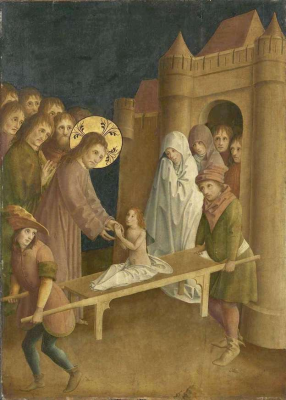Gospel in Art: 'Do not cry' He said to the widow of Nain

Raising of Widow's Son at Nain, by Master of the Darmstadt Passion, 1445 © Alte Pinakothek, Munich
Source: Christian Art
Gospel of 17 September 2024
Luke 7:11-17
Jesus went to a town called Nain, accompanied by his disciples and a great number of people. When he was near the gate of the town it happened that a dead man was being carried out for burial, the only son of his mother, and she was a widow. And a considerable number of the townspeople were with her.
When the Lord saw her he felt sorry for her. 'Do not cry' he said. Then he went up and put his hand on the bier and the bearers stood still, and he said, 'Young man, I tell you to get up.' And the dead man sat up and began to talk, and Jesus gave him to his mother. Everyone was filled with awe and praised God saying, 'A great prophet has appeared among us; God has visited his people.' And this opinion of him spread throughout Judaea and all over the countryside.
Reflection on the painting
Today, we encounter a woman overwhelmed by profound grief, having just lost her only son. Imagine the depth of her sorrow, the hopelessness she must have felt. Her son was likely her greatest source of joy, love, and security. She is known simply as the 'widow of Nain'-no name, no further details are given.
Then, in the midst of her despair, something extraordinary happens. Jesus arrives, and with a simple yet powerful command, He changes everything. He tells her, "Do not cry," before performing the miracle of raising her son from the dead. What does this teach us? It shows that nothing-not even death-lies beyond the power of Christ. If he can bring hope to the widow of Nain in her darkest hour, we too can entrust Him with all our worries, troubles, and fears.
The painting, attributed to the Master of the Darmstadt Passion, one of the most skilled mid 15th century artists of the Middle Rhine region, portrays this scene with profound symbolism. The widow is dressed not in black, but in white-a colour that represents the hope. Although still weeping, her white cloak suggests the promise of new life. The son, though depicted as an adult, is reduced in size to emphasise his role as her 'child.' His hands are clasped in prayer, a gesture of gratitude to the Lord, while Christ gently embraces them. The awe of the onlookers, described in Luke's account, is palpable in the expressions of the crowd, their faces filled with wonder.
LINKS
Gospel in Art: https://christian.art/
Today's Reflection: https://christian.art/daily-gospel-reading/luke-7-11-17-2024/


















